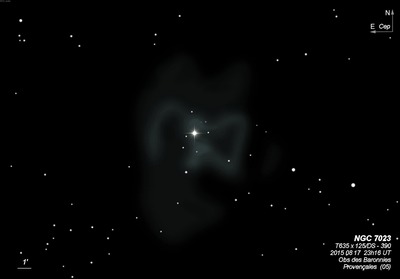Iris Nebula
Iris Nebula

William Herschel discovered NGC 7023 = H IV-74 on 18 Oct 1794 (sweep 1063) and recorded "7m. A star very much affected with nebulosity that more than fills the field, it seemed to extend to at least a degree all round; small stars such as 9 or 10m of which there are a great number, are perfectly free from this appearance, but everything about the telescope being very damp, I have suspicion of a deception." Per Collinder mistakenly equated a cluster (Cr 429) with NGC 7023. Cr 427 is a very faint cluster close west, though Archinal and Hynes noted "His position for Cr 429 fall precisely on the actual location for the real cluster here, Cr 427. And Collinder's position for the real cluster falls 1 minute to the west of it on comparitively empty sky."
In 1907 Max Wolf photographed the nebula with the 28" reflector of the Konigstuhl Observatory and found the nebula was encircled by a lacuna or ring 0.5° in diameter, which is "absolutely empty of faint stars" [dubbed a "Hohlennebel" or "cave-nebula"] . He noted "In spite of the small field of the reflector-plate, there was evidence that the cavity was the end of a channel entering the picture almost exactly from the south...The nebula itself is a very remarkable object. In many respects it resembles in form the Pi2 Cygni nebula [IC 5146 = Cocoon Nebula]." The surrounding void was first photographed by Dr. Roberts. The reflection nebula vdB 152, also in Cepheus, is another example.
200/250mm - 8" (8/28/81): nebulosity extends south of the mag 7.5 star with averted vision using 100-125x. A very faint star is at the south edge.
300/350mm - 13.1" (9/22/84): the dark lane appears to be following the central star and oriented ~N-S.
13.1" (9/11/82): bright, large nebulosity surrounding a mag 7 star. There is a sharp light cut-off on the east side near the bright star, although nebulosity extends beyond.
400/500mm - 17.5" (8/13/88): very prominent unusual nebulosity surrounding mag 7.4 SAO 19158. A dark lane oriented SSW-NNE is following the bright star. Nebulosity may extend to a star 3' SSE that also has a halo.
Notes by Steve Gottlieb